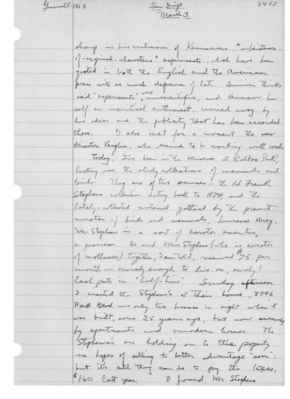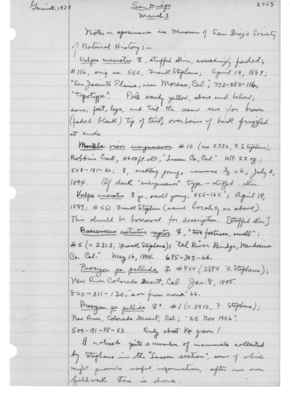Pages That Mention Frank Stephens
1925: Joseph Grinnell's field notes
S1 Page 4
Collector: Grinnell - 1925 Location: San Diego Date: March 3, 1925 Page Number: 2453
sharp in his criticism of Kammerers "inheritance of-acquired-characters" experiment, which have been quoted in both the English and the American press with so much deference of late. Sumner thinks said "experiments" were unscientific, and Kammerer him self an incritical enthusiast, carried away by his and ideas and the publicity that has been accorded them. I also met for a moment the new Director Vaughn, who seemed to be working with corals.
Today, I've been in the Museum at Balboa Park, looking on the study collections of mammals and birds. They are of two sources - the old Hawk Stephens collection dating back to 1874, and the lately-collected material gathered by the present curator of birds and mammals, Laurence Huey. Mr. Stephens is a sort of curator emeritus, a pensioner. He and Mrs. Stephens (who is curator of molluscs) together, I am told, received $75 per month - scarcely enough to live on, surely! Each puts in "half-time." Sunday afternoon I visited the Stephens's at their home, 3746 Park Blvd. - only two houses in sight when it was built, some 25 years ago, but now surrounded by apartments and modern homes. The Stephens are holding on to this property in hopes of selling to better advantage "soon"' but its all they can do to pay the taxes, $160 last year. I found Mr. Stephens
S1 Page 6
Collector: Grinnell - 1925 Location: San Diego Date: March 3, 1925 Page Number: 2455
Notes on specimens in Museum of San Diego Society of Natural History:
Vulpes macrotis [male symbol], stuffed skin, exceedingly faded; #116, orig no. 550, Frank Stephens; April 19, 1889; "San Jacinto Plains, near Moreno, Cal."; 772-282-116; "topotype". Pale sandy yellow, above and below; ears, feet, legs, and tail the same save for brown (faded black) tip of tail; overhairs of back frizzled at ends. Mustella vison energumenos #10 (no 2336, F. Stephens); Robbins Creek, 4600 ft. alt., "Lassen Co., Cal." Wt. 22 oz.; 508-181-50; female, suckling young, mammae 3/3 = 6; July 3, 1894. Of dark "energumenos" type - stuffed skin. Vulpes macrotis female ju., small young, "445-165"; April 19, 1889; #551 Frank Stephens (same locality as above). This should be borrowed for description. [Stuffed skin.] Bassariscus astutus raptor female, "two foetesus, small"; #5 (= 2313, Frank Stephens); "Eel River Bridge, Mendocino Co. Cal." May 16, 1894. 695-343-66. Procyon ps. pallida female #954 (2894 F. Stephens); New River Colorado Desert, Cal. Jan. 8, 1894. 820 - 311 - 130, "ear from crown" 66. Procyon ps. pallida female° #1 (= 3412, F. Stephens); New River, Colorado Desert, Cal.; "25 Nov 1906." 500 - 191 - 98 - 53. Only about 1/4 grown! I noticed quite a number of mammals collected by Stephens in the "Lassen section", some of which might provide useful information, after our own fieldwork there is done.
S3 Page 72
Collector: Grinnell - 1925 Location: San Diego Date: November 1, 1925 Page Number: 2614
This morning, 9-10, I called in Mr. + Mrs. Frank Stephens at their old home, now in the heart of modern residence district, 3746 Park Blvd. I found Mr. Stephens (now 76 he told me) quite vigorous, of both mind and body, and I had a very pleasant visit with him. Among items of news was the death, of typhoid down in Mexico somewhere, a month or so ago, of Jose Maria Gallegos, who was the Mexican museum representative at Tijuana. No successor has as yet been appointed. One thing of interest Stephens showed me was a 4-foot section of a young pine trunk from portions of which the bark had been gnawed "by Porcupines". This sample Mr. Stephens got, himself, in July, 1923, one-fourth mile above the hotels at Bluff Lake, San Bernardino Mountains, in a grove of young pines many of them showing similar "sign". I examined the section (4 inches in diameter at one end, 2 1/4 inches at the other) closely, but could see none of the characteristic lower-incisor marks on either the bared wood or the adjacent bark; so I doubt it's being Porcupine work, tho Mr. Stephens is sure it is, and he very much resented my intimation otherwise. Wright M. Pierce knows more about this "evidence"; no actual specimen of Porcupine has ever been forthcoming from the San Bernardino, altho rumors of their presence there keep bobbing up.


